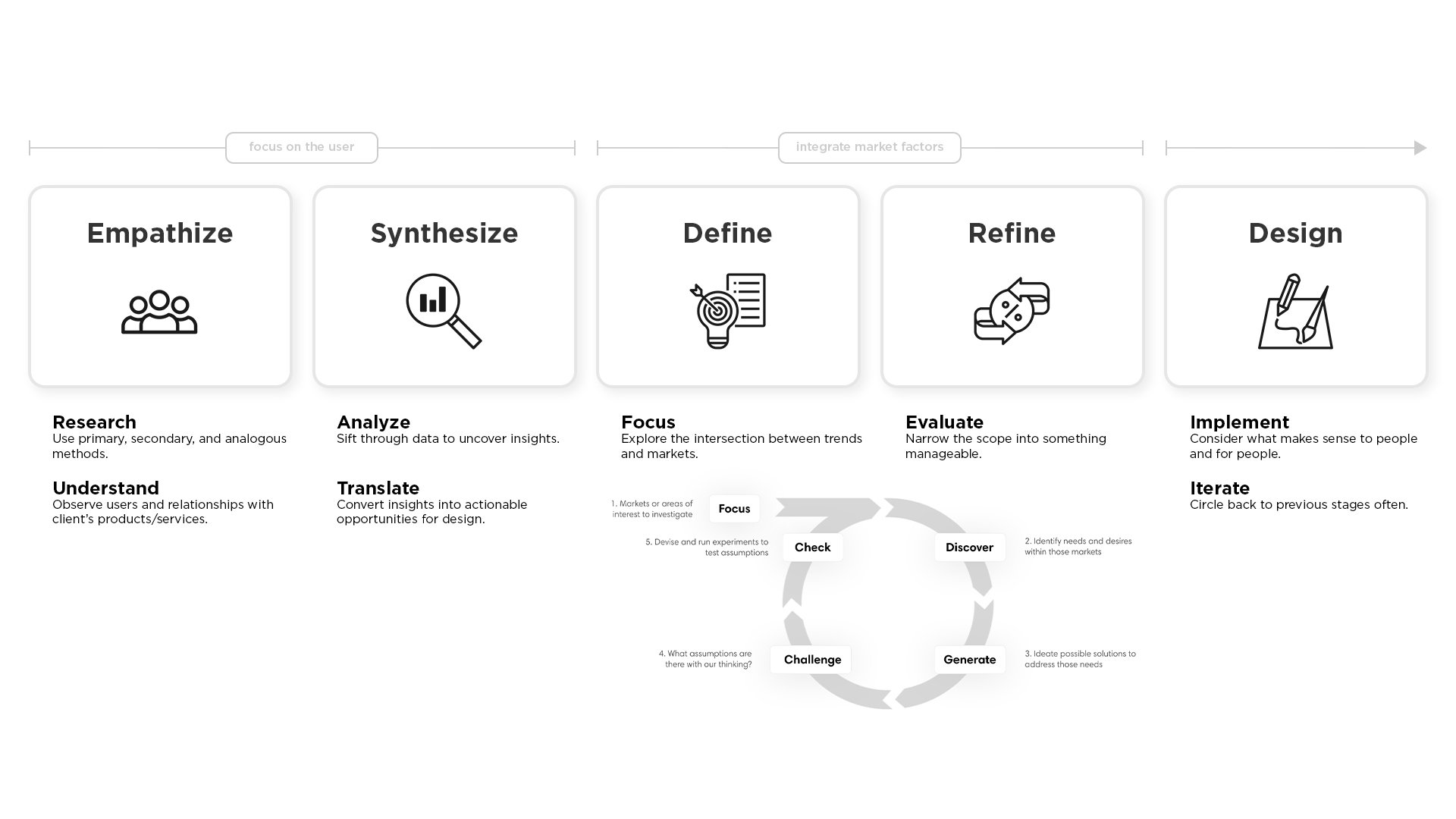Designer | Researcher | Strategist
If this is the design process, where does Design Strategy fit in?
A continuously evolving
Design Strategy Framework:
Note: although this framework is displayed linearly, it is an iterative process and each step is revisited and implemented as needed.

Define & Refine phases:
This is a cyclical process that usually goes through multiple iterations.
-
Focus is about defining a starting point – a place to go looking for opportunities. During this stage, we want to find a number of Focus Areas. Focus Areas are the intersection between trends and markets.
-
Focus Areas are usually free from specific insights or customer needs. Discover is about finding them. This is sometimes referred to as the “market gap”. In this stage we will use initial desk research and market benchmarking to define areas of opportunity or unmet need.
-
This stage is about ideating possible solutions to address the user needs or desires found in Discover. We want to come up with a number of divergent HMWs (How Might We’s) per Focus Area. Later we will synthesize user needs into product requirements.
-
This stage is about identifying assumptions and challenges in our generated ideas. These are usually identified in a Challenge Session, where everyone has an opportunity to constructively teardown an idea, so we can build it back up. The goal is not to kill ideas during this process, but to look for high risk/problem areas in each idea.
-
This stage is about using methods to prove or disprove assumptions identified from the Challenge stage. These methods can take the form of surveys to plug gaps from desk research, additional interviews about specific unmet user needs, observation of users and behaviors in real world situations, empathy mapping techniques, and more.
Guiding Principles:
Ask how something could work, as opposed to why it won’t.
It’s easy to shit on ideas. An app that lets you stay in a stranger’s house? Self-destructing photos? Remember most new ideas seem dumb, until suddenly they’re not.
[Founders Factory]
Shift your perspective.
To find those “ah-ha!” moments, try picking a closely held assumption about a problem and then seeing what would happen if you broke it. Or, draw insights from disparate fields and apply them in fresh, unexpected ways.
[X, the Moonshot Factory]
It’s ok to challenge conventional wisdom.
Design like you are right, test like you are wrong.
[Founders Factory]
Embrace failure learning.
Taking moonshots isn’t possible without failing a few times along the way. The trick is to create a culture that makes it psychologically safe for people to fail, and reframes each failure as an opportunity to learn.
[X, the Moonshot Factory]
What makes innovative teams successful?
Teams who use their purpose to guide their decision-making have 61% more successful launches than teams that don’t.
Teams that have access to information about prior initiatives are 51% more likely to create successful solutions than teams that don’t.
source: IDEO
How can I help your design team?
I focus on the first 4 phases outlined in the framework above to help prepare your team for their design process. My goal is to equip them with the tools, data, and insights needed to fuel ideation and make informed design decisions.
I’ve compiled a lot of design and strategy resources from industry leaders such as IDEO, Fast Company, Founders Factory, LeanStack, Peer Insight, Lextant, Cascade, X, the Moonshot Factory, and others that I can bring to the table.
I’m also familiar with Industrial Design and Design Thinking processes and am happy to help with this phase, or I can let your team do their own thing. While they’re cranking out ideation sketches, I can conduct follow-up field research, analyze desk research, identify emerging technologies and market trends, organize and archive our new data sets, map out user journeys and personas, build physical prototypes, create client presentations and pitch decks, and more.
